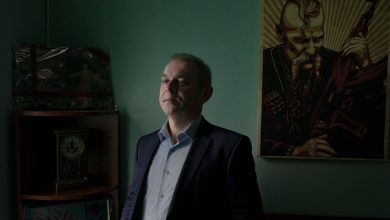Carlos Saura, a Leading and Enduring Spanish Director, Dies at 91

Carlos Saura, a Spanish director who began making films during the regime of Francisco Franco and was still making them at his death, exploring Spanish identity through allegory-rich storytelling and, later, vividly capturing flamenco and other art forms, died on Friday. He was 91.
The Academy of Cinematographic Arts and Sciences of Spain said he died at his home but did not say where. The next day, the Goya Awards, Spain’s annual film awards, had planned to present him with the Honorary Goya Award in recognition of his “having shaped the history of modern Spanish cinema,” as the organization put it when announcing the award last October.
Instead, he received the statuette a few days before his death, the organization said. It called him “one of the fundamental filmmakers in the history of Spanish cinema.”
Mr. Saura was a photographer who began making short films in 1956 and released his first feature, “The Delinquents,” about youths living on the edge in Madrid’s slums, in 1959.
Filmmakers under Franco, who came to power during the Spanish Civil War in the late 1930s and controlled the country until his death in 1975, had to be careful not to run afoul of censors. Mr. Saura became adept at alluding obliquely to Spanish history and the strains the country endured, as he did in his third feature film, “The Hunt” (1966), the story of two middle-aged men who go on what is supposed to be a relaxing rabbit hunt with a business tycoon and his nephew. Things take a brutal turn.
When the movie played in Manhattan in 1967, Bosley Crowther wrote in The New York Times, “The vivid manifestations of wholesale shooting of frightened rabbits as they scoot across the hills of an area that was a famous section of battlefield in the Civil War are unmistakable allusions to that conflict of friend-against-friend and brother-against-brother that so thoroughly affected the politics and society of Spain.”
“‘The Hunt,’” he added, “is the toughest Spanish picture I have ever seen, and the most amazingly revealing.”
That kind of filmmaking sometimes got him in hot water with government censors. In 1971, his initial script for “Anna and the Wolves” was blocked by the Information Ministry. It told the story of a young governess who takes a job in a broken-down mansion inhabited by three brothers, each of whom pursues her.
“They represent for me the three monsters of Spain,” Mr. Saura told The Times in 1971, “perversions of religiosity, repressed sexuality and the authoritarian spirit.” Of having his script blocked, he said, “They have made dust of me.”
He eventually made the movie, however; it showed at the Cannes Film Festival in 1973. The movie starred Geraldine Chaplin, a daughter of Charlie Chaplin, who had appeared in several other Saura films and had a long romantic relationship with him. Her character meets a gruesome end.
“The ending, when she is raped, shot and tortured by her respective assailants, is an unmistakable indictment of Spain’s stifling social conventions,” the film critic Alexander Walker wrote in The Evening Standard of London, “and a brave one to have made on the home ground.”
The year after Franco’s death, Mr. Saura won a special jury award at Cannes with another film that looked to the past, “Cría Cuervos,” about a girl (played by Ana Torrent, who went on to a long career) with a trauma-filled childhood. (Ms. Chaplin played her as an adult.) Vincent Canby, writing in The Times, called the movie “funny and heartbreaking and bursting with life.”
Mr. Saura soon began to focus on cultural subjects, especially dance, whose beauty and excitement he had a knack for capturing on film. “Blood Wedding” (1981), “Carmen” (1983) and “El Amor Brujo” (1986) all featured the flamenco dancer Antonio Gades. “Flamenco” (1995) was a music- and dance-filled documentary, as was “Flamenco Flamenco” (2010). “Tango” (1999) was a musical drama built around that dance genre.
“It’s no slight to the lovers seen in Carlos Saura’s thrilling ‘Tango’ to say that the kissing seen here is less torrid than the dancing,” Janet Maslin wrote in her review in The Times.
Marvin D’Lugo, a professor at Clark University and the author of “The Films of Carlos Saura: The Practice of Seeing” (1991), drew a connection between the director’s work during the Franco years and after them.
“Saura’s great theme was the painful memories of the Civil War visited on contemporary Spaniards,” he said by email. “A photographer before he was a filmmaker, his particular genius, and what brought him to international acclaim early on, came from his unique ability to visually translate trauma onto the bodies of his characters. This is as much a cultural as a political narrative thread, and it guided him in the post-Franco years as he shaped the plots of his dance films around the images of bodies now creatively submitting to artistic design.”
Carlos Saura Atarés was born on Jan. 4, 1932, in Huesca, in northeastern Spain. His mother was a pianist, and his father worked in the Interior Ministry. After the Civil War he was separated from his parents for a time, living with his maternal grandmother, but the family eventually reunited in Madrid.
He studied engineering at the University of Madrid but was also having some success as a photographer, particularly with portraits of ballet and flamenco dancers, and in 1952 he switched to the recently created National Film School.
Mr. Saura’s most recent film, “Las Paredes Hablan,” a documentary about art, was released a week before his death.
His survivors include his wife, Eulàlia Ramón, and several children.
Mr. Saura made a sequel of sorts to “Anna and the Wolves” called “Mama Turns 100,” released in 1979. The contrast was notable: “Anna,” made during the Franco years, was a drama; “Mama,” looking in on some of the same characters, was more of a comic drama. It was nominated for the Oscar for best foreign language film.
It was as close as he came to realizing one dream.
“I often think it would be fantastic, a magnificent experience, to make the same picture over and over, year after year,” he told LA Weekly in 1984, “to watch it evolve — to see things differ.”




